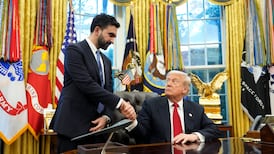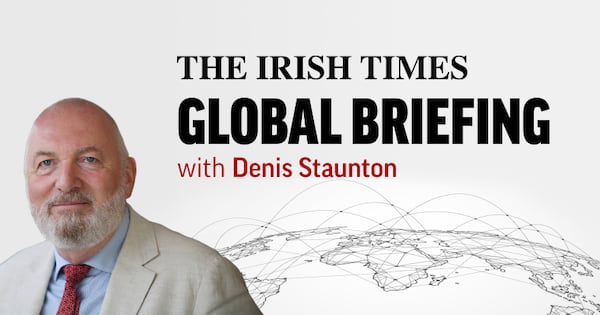January 20th: Rioters pardoned
On an icy afternoon in Washington, the second Donald Trump term begins with fire and brimstone. But not even the most partisan Maga supporters could have predicted this much fire, this much brimstone. A deluge of executive orders (EOs) indicates the speed and scope of the changes they set in motion.
The day one orders include “Unleashing American Energy”, to promote fossil fuel exploration and production on US federal lands; the declaration of a national energy emergency (the first in US history); withdrawal from the Paris Climate Accord; an order “ending the weaponisation of the federal government”; restoring accountability in the federal workplace; ending radical and wasteful government DEI (diversity, equality and inclusion) programmes; an order to recognise two genders – male and female – at federal level, under “Defending women from Gender Ideology Extremism”.
Plus, there’s the establishment of the department of government efficiency (DOGE), the federal government wrecking ball to be headed by Elon Musk; a return to in-person work and a hiring freeze; and “Restoring Names that Honor American Greatness”, namely the Gulf of Mexico becoming the Gulf of America and Mount Denali, in Alaska, restored to Mount McKinley, after William McKinley, the slain president for whom Trump has expressed admiration.
Perhaps the most contentious order is the mass pardon or commutation of sentencing for those charged and convicted for participation in the January 6th, 2021 riots on Capitol Hill.
RM Block
January 21st: Money for AI
After meeting Republican members of Congress, Trump announces a $500 billion AI infrastructure investment. Three tech billionaires – Sam Altman of OpenAI, Masayoshi Son of SoftBank and Larry Ellison of Oracle – announce the project from the Roosevelt Room in the White House, along with the president. Not present is Elon Musk, who takes to his social media platform to trash the project, saying it lacks funding credibility.
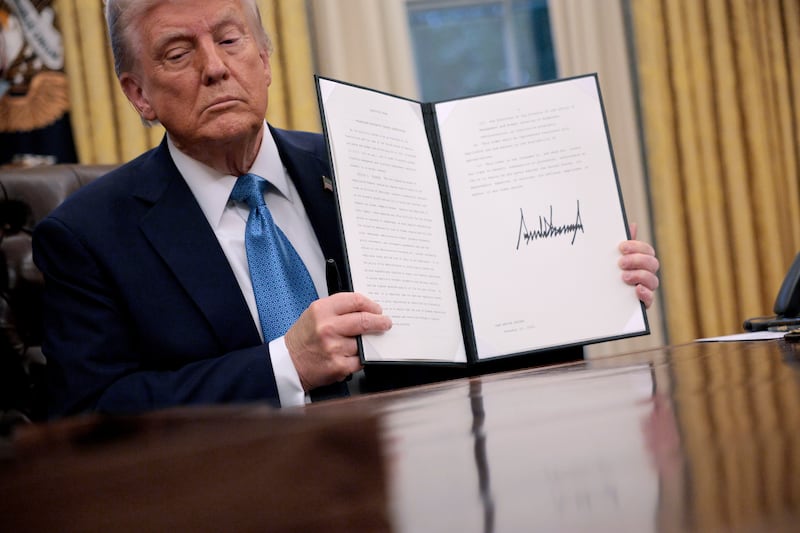
January 22nd: Sit-down with Sean
The first sit-down television interview is with Sean Hannity, one of Trump’s most loyal media figures. During the hour-long conversation, Trump returns to his grievance over federal investigations on January 6th and notes that it may be a “sad thing” that Joe Biden didn’t pardon himself before leaving office.
January 23rd: Better call Saudi
The first foreign leader to receive a call from the new US president is Crown Prince Mohammed bin Salman of Saudi Arabia. Under discussion is stability in the Middle East and Saudi international ambitions. Last summer the Trump organisation announced that its next hotel will be built in Riyadh.
Late in the afternoon, Trump signs another tranche of EOs while holding court with the media in the Oval office. He rescinds Joe Biden’s order curtailing the exploration of AI potential and also declassifies the federal records on the assassination papers of John F Kennedy, Robert F Kennedy and Martin Luther King.
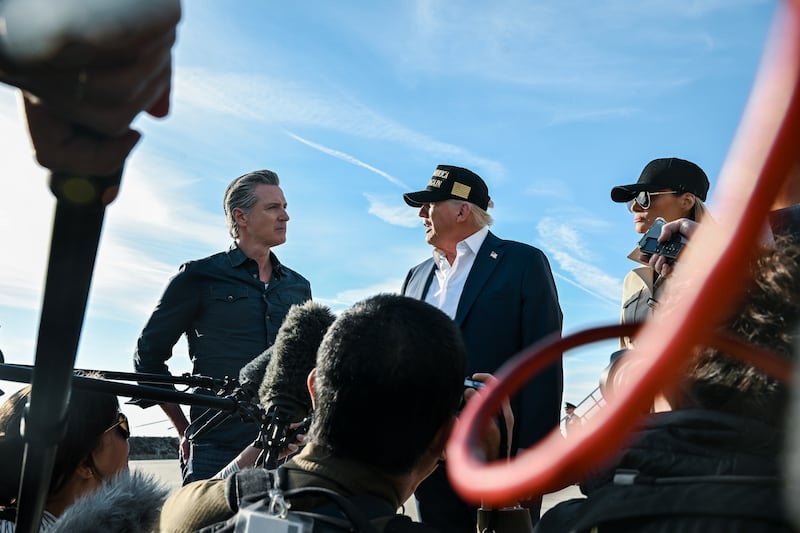
January 24th: Visit to LA
For his first official White House trip, Trump visits areas in North Carolina ravaged by recent floods and travels across to Los Angeles to inspect the urban devastation caused by the ongoing wildfires. He has repeatedly blamed Democratic California governor Gavin Newsom for causing a water shortage by choosing to protect an “essentially worthless fish called a smelt”, a position that was debunked by fact-checkers.
Newsom is waiting for the president when his plane touches down and the two engage in a brief but cordial conversation for the cameras, with Trump committing to help the city in its recovery. Visiting a firehouse, he praises the first responders there, later reiterating his criticism of the Democrats.
January 25th: Greenland grab
Speaking to reporters on Air Force One, Trump returns to a subject that generated controversy before his inauguration: his desire to acquire US control of Greenland. “I think we’re going to have it,” he says, maintaining that the majority of Greenland’s 57,000 residents would like the US to assume control of what is an autonomous Danish territory.
[ Danish prime minister clashes with Trump over GreenlandOpens in new window ]
Donald Trump jnr had flown to the island on a five-hour visit on January 7th serving as an unofficial emissary and telling residents, “‘We’re going to treat you well.” In the days afterwards, Mr Trump said he would not rule out the use of military force and claimed that the development is an “absolute necessity” for US and international security. He also announced his intention to return the Panama Canal to US control.
January 26th: 956 arrests
Federal raids take place in Chicago, Miami and Newark, New Jersey, resulting in 956 arrests by the Immigration and Customs Enforcement of immigrants, the biggest single-day figure since the Trump administration initiated its campaign promise of mass deportations of undocumented migrants. The development escalates tensions between the government and elected leaders in the so-called sanctuary cities.
“Newark will not stand by idly while people are being unlawfully terrorised,” Ras Baraka, the mayor, says afterwards. Tom Homan, the border tsar of the new regime, warns that undocumented people who are arrested in raids targeting criminals will also be deported.
January 27th: Panama plan
Monday begins with a repeated vow to “take back the Panama Canal”, with claims that China has taken control of the vital shipping route.
“China is running the Panama Canal that was not given to China, that was given to Panama foolishly, but they violated the agreement, and we’re going to take it back, or something very powerful is going to happen,” Trump tells reporters. By this point, secretary of state Marco Rubio has already embarked on his first official overseas trip, meeting Panama’s president, Raúl Mulino.
EOs concentrate on recasting the US military in the mould set out by Pete Hegseth, the controversial choice for defence secretary, with an order to abolish DEI offices and programmes, and a reinstatement of military personnel who refused the Covid vaccine.
January 28th: Aid freeze halt
Minutes before a federal aid freeze announced by Trump is due to come into effect, a DC judge, Loren Alikhan, grants a temporary halt after hearing from advocacy groups about the devastating instant consequences. He will go on to extend the block and a Rhode Island judge will issue a similar order later in the week.
January 29th: Exec order on gender
Trump signs an executive order to end “radical indoctrination in American classrooms”. The order sets out the prevailing environment as an “echo chamber” which forces students to accept ideologies which compel them to “adopt identities as either victims or oppressors based on their skin colour and other immutable characteristics”.
[ Trump signs order intended to bar transgender athletes from women’s sportsOpens in new window ]
Prevailing practices also mean “young men and women are made to question whether they were born in the wrong body” and “not only erode critical thinking but also sow division, confusion and distrust, which undermine the very foundations of personal identity”.
In a separate issue, Trump suggests that up to 30,000 migrants could be housed at Guantánamo, the notorious detention facility. In the evening, word of a horrifying air disaster breaks.
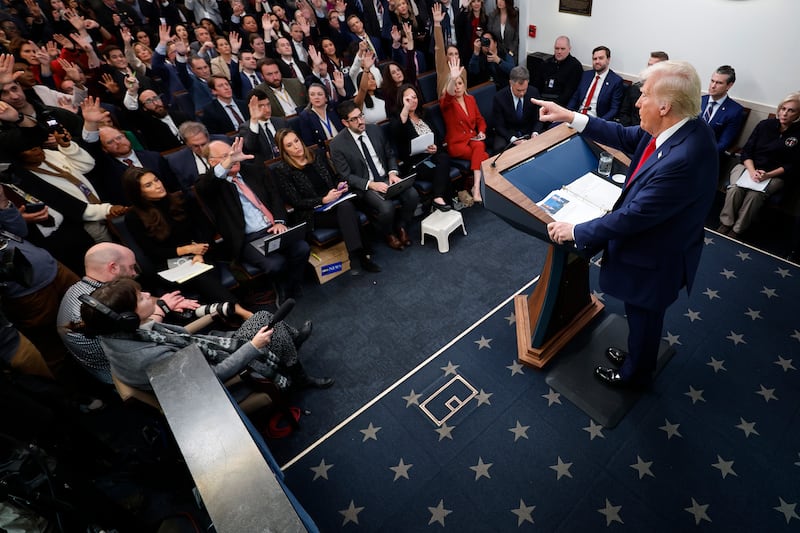
January 30th: Air crash blame game
On the evening of January 29th, the worst American aviation disasters of the past 15 years occurs at Reagan National Airport in Washington. A military Black Hawk helicopter has collided with a passenger jet as it approached the runway. Both aircraft plunge into the Potomac river: an instant rescue effort yields no survivors out of the 67 victims.
In a live press conference, Trump makes a radical break from tradition in offering his own take on the reasons for the crash and implies that the blame for the tragedy might lie with the policy of DEI that occurred during Democratic terms in office, name-checking former presidents Biden and Obama, and Pete Buttigieg, the last transport secretary.
It later emerges that staffing levels were “not normal” in the control tower at the airport at the time of the collision, according to an air traffic safety report described to the Washington Post. Investigations into the causes of the crash are ongoing.
February 1st: Tariffs announced
February arrives with a Saturday confirmation that the US government will implement tariffs of 25 per cent on imports from Canada and Mexico, and 10 per cent on all imports from China. The measure, the White House states, is in response to “the extraordinary threat posed by illegal aliens and drugs, including deadly fentanyl”, which “constitutes a national emergency under the International Emergency Economic Powers”.
The news is greeted with dismay and a vow to impose countermeasures from Canada and Mexico. In a direct address to the American people, Canadian prime minister Justin Trudeau reminds them: “In your darkest hours we were always there, standing with you, grieving with you.”
The tariffs, a key part of Trump’s campaign manifesto, lead to predications by analysts that they will result in inflation of the cost of living for Americans. International stock market turmoil is predicted; the opening hours of trading in eastern countries bear this out.
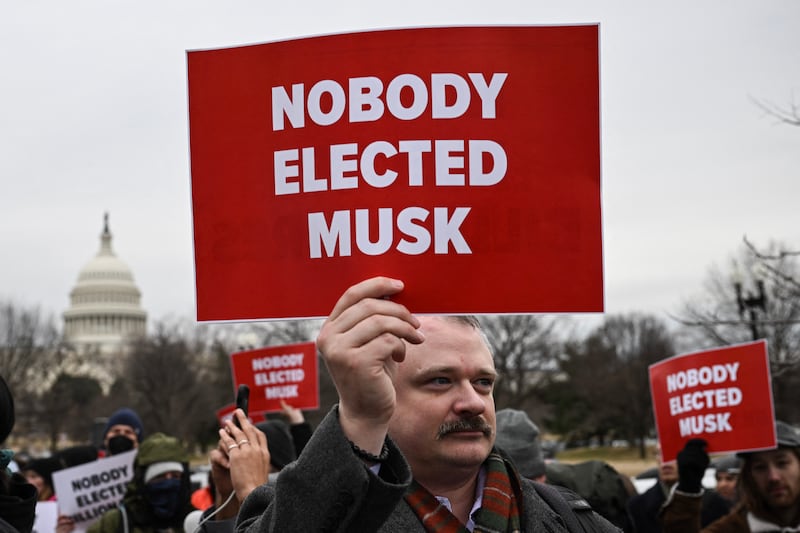
February 3rd: Tariffs paused
It emerges that Trump has held an 8am phone call on Monday with Mexican president Claudia Sheinbaum. They have agreed to pause what would have been a trade war for at least a month. Trump lets it be known that Mexico will send 10,000 troops to police the US-Mexico border with immediate effect. Sheinbaum later clarifies that the conversation also included an agreement to limit the flow of US weapons across the border into her country.
[ Donald Trump remains besotted with tariffs and Europe is nextOpens in new window ]
A similar pause is announced in Canada, with the appointment of a Canadian border tsar as part of the US-Canada deal. Mr Trump claims to “be very pleased with the initial outcome,” but whether the threat of countermeasures was enough to call his bluff will become apparent when the 30-day grace period ends at the beginning of March.
Meanwhile, Musk’s Doge announces, via X, that it too had a busy weekend “feeding USAid into the wood-chipper”. Federal employees of the massive aid relief funding programme are told not to come to work and all funding is temporarily halted for 90 days. Four days later, the State Department announces that vital humanitarian assistance programmes could continue through special waivers granted to select programmes.
February 4th: ‘Riviera of the East’
Israeli prime minister Binyamin Netanyahu, having arrived in Washington on Sunday evening, is greeted by Trump at the White House, their handshake within earshot of the pro-Palestine protests taking place outside. Netanyahu is the first foreign leader to visit the White House in the second Trump term.
Reflecting on their harmonious relationship between 2017 and 2021, Trump vows to bring peace to the Middle East and, at a press conference in the East Room, draws international shock and strenuous objection when he announces his idea of relocating the Palestinian people from Gaza and redeveloping the area into a Mediterranean-type resort that he describes as “the Riviera of the East”. The solution, he claims, will allow Palestinians to live in peace, realising in the process what he sees as the untapped real estate potential of the Gaza Strip.
The presentation of a historically freighted place and site of an ongoing humanitarian disaster in the language of a real estate deal leaves international leaders and commentators flabbergasted. Several political figures describe the suggestion as “ethnic cleansing”. At the press conference, Trump envisages the Palestinian people permanently leaving Gaza but is unclear where they will live.

February 5th: Threat of lawsuits
The international response to president Trump’s Gaza idea is uniform in a stout chorus underlining its impossibility and illegality. At the lunchtime White House briefing, press secretary Karoline Leavitt states that Trump had not committed to any US military “troops on the ground” in Gaza. Initial economic projections forecast that, leaving the moral implications of the proposal aside, it would cost something in the region of $100 billion to bring the plan to fruition.
USAid workers and Democratic leaders protest the chaotic effect of the USAid suspension and Musk’s unprecedented power outside Congress. USAid employees begin to discuss lawsuits against the administration.
February 6th: Baffling speech
In what was the most baffling speech of his presidency to date, Mr Trump spoke at the annual National Prayer Breakfast, in front of congressional members from both sides of the House and preached a message of bipartisan unity.
In reflective mood, he recalled his youthful veneration of congressional representatives and raised the name of a former Democratic representative who had been a dinner buddy of his father’s, and someone Trump admired. “Sy Halpern,” he said, wondering if anyone remembered the 1960s-era politician. He vowed that harmony and collegiality would reign again on Capitol Hill. “Democrats are going to be able to have lunch again, and dinner, with Republicans,” he said.
He also announced plans for a new park featuring a statue garden to honour the great Americans throughout history.
Later he signed an executive order imposing sanctions on the International Criminal Court. The order accuses the court of having “engaged in illegitimate and baseless actions” targeting the US and its “close ally” Israel, and said the court “abused its power” by issuing “baseless” arrest warrants targeting Binyamin Netanyahu and former Israeli defence minister Yoav Gallant.
- Sign up for push alerts and have the best news, analysis and comment delivered directly to your phone
- Join The Irish Times on WhatsApp and stay up to date
- Listen to our Inside Politics podcast for the best political chat and analysis









